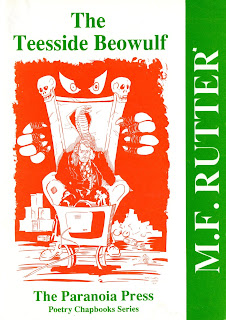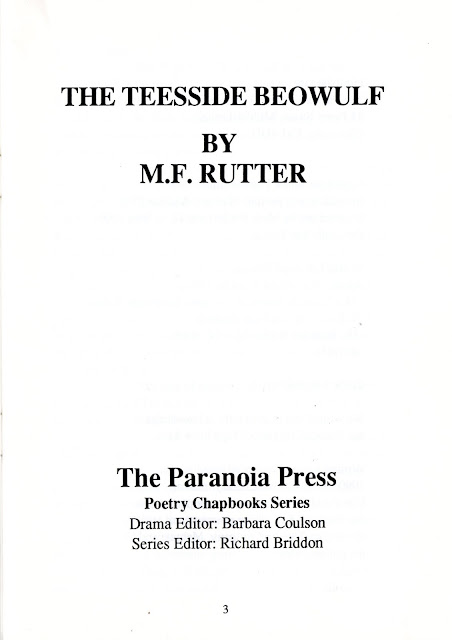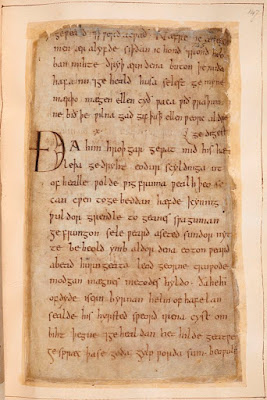Richard Briddon, Editor of Teesside’s Paranoia Press in 1990, wrote, in the introduction to Mark F.
Rutter’s chapbook The Teesside Beowulf, as follows –
“The original Beowulf is without doubt the greatest piece of dark age poetry written in any Teutonic language. Based on a semi-mythical character who is brought in to defeat the warrior-devouring monster, Grendel, and subsequently his even nastier mother; Beowulf was an oral tale written down in Northumbria and ‘converted’ for the purposes of disseminating the then current (Christian) ideology. It was probably a tale local to the place of its setting down, well known to the monks of the region.
There are two likely sites for it’s creation, a northern site at Lindisfarne where famous gospels were written, and a southern site based on the religious centres of Whitby and Durham, (and so neatly encompassing the Teesside area).
Briefly, the argument for the latter is a s follows: Beowulf’s traditional burial place is inside the boundaries of modern Cleveland, at the tumulus on Boulby Cliff, the highest point on the North-East coastline. More evidence for the south comes from the Beowulf manuscript which varies considerably from the distinctive Lindisfarne style of lettering, and from the many local Beowulf connections
like the Hartlepool coat of arms, which resembles the opening scene of the poem. It has also been suggested
that Lindisfarne was interested in creating visual art in honour of God, while the other poets like Caedmon, the first English Poet, the south was more interested in literary creation.
Of course it will never be proved, north or south, but surely there is enough to go to prevent the official organisers of Cleveland culture from ignoring the poem’s local connections!”
From http://www.sclews.me.uk/m-beowulf.html
“Beowulf is the first major poem in any European vernacular language, and is not only much the longest work of the thirty thousand lines of Old English (Anglo-Saxon) that remain to us, but is incomparably the greatest. The historical period described may be the 6th century AD, but we only possess a much later manuscript. The poem is generally thought to have achieved its present form around the time of Bede (q.v.).”
‘Upon the headland, the Geats erected a broad high tumulus plainly visible to distant seafarers...’
Old Cleveland
Over a hundred years before Rutter and Briddon, and the above site, W.H. Burnett – poet and editor of Middlesbrough’s Daily Exchange, wrote, in his 1886 book Old Cleveland- Local Writers and Local Worthies, thus –
“It is unnecessary to nice the guess made by professor Morley as to the residence of Beowulf on the Bowlby Cliffs (Boulby near Loftus, East Cleveland). It is merely a conjecture, and nothing more. That picturesque locality, inaccessible to invasion as it must have been in early times, was certainly a fit spot to be the cradle of English song….”
“Professor Henry Morley in his First Sketch of English Literature 1873, tells us that on the English coast, strong settlements were effected by the pagan Teutons, who between 600 and 700, made frequent incursions on our shores. ” The Teutonic settlers brought with their battle songs an heroic chief named Beowulf “. This legend assumed vast shape, probably in the 7th century, and is one of the earliest specimens of English Literature……….”The original scene of the story,” continues Mr. Morley, “was probably a corner of the island of Sealand, upon which now stands the capital of Denmark, the corner which lies opposite to Gothland, the southern promontory of Sweden. But if so, he who in the country told the old story in English metre did not paint the scenery of Sealand, but that which he knew. A twelve mile walk by the Yorkshire coast, from Whitby northward to Bowlby Cliff, makes real to the imagination of all the country of Beowulf as we find it in the poem. Thus we are tempted to accept a theory which makes that cliff, the highest on our eastern coast, the ness upon which Beowulf was buried, and on the slopes which, Bowlby (Boulby), then being read as the corrupted form of Beowulfs-by – Beowulf once lived with his hearth-shares. High sea-cliffs, worn into holes or ‘nickerhouses many’ with glens rocky and wooded running up into great moors, are not characters of the coast of Sealand, opposite Sweden, but they are special characters of that corner of Yorkshire in which the tale of Beowulf seems to have been told as it now comes to us in first English verse.“
The piece on Beowulf from William Hall Burnett‘s Old Cleveland – Local Writers and Local Worthies 1886. Click arrow to enlarge or down load from Google Drive.
Except pages from Teesside Beowulf by MA Rutter – Paranoia Press (now apparently unavailable).
Beowulf – An Anglo-Saxon Epic Poem, Translated From The Heyne-Socin Text by Lesslie Hall





